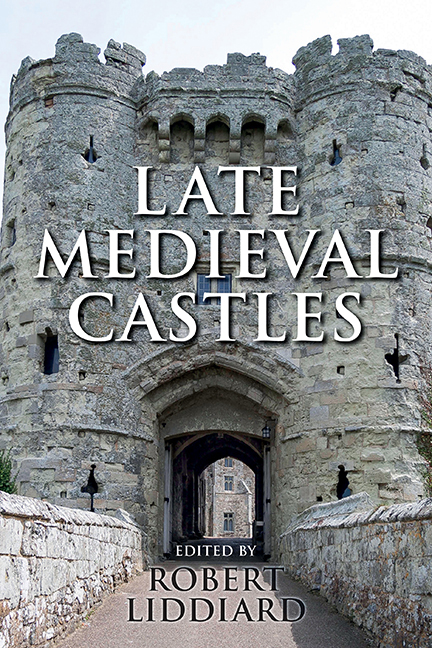Book contents
- Frontmatter
- Contents
- List of Illustrations
- Acknowledgements
- Editor's Preface
- List of Abbreviations
- A Note on the Text
- Introduction
- 1 Fourteenth-Century Castles in Context: Apotheosis or Decline?
- 2 Architects, Advisors and Design at Edward I's Castles in Wales
- 3 The Courtyard and the Tower: Contexts and Symbols in the Development of Late Medieval Great Houses
- 4 Castle Planning in the Fourteenth Century
- 5 Meaningful Constructions: Spatial and Functional Analysis of Medieval Buildings
- 6 Mota, Aula et Turris: The Manor-Houses of the Anglo-Scottish Border
- 7 Lulworth Castle, Dorset
- 8 A Scottish Problem with Castles
- 9 Structural Symbolism in Medieval Castle Architecture
- 10 Specimens of Freedom to Crenellate by Licence
- 11 Some Analysis of the Castle of Bodiam, East Sussex
- 12 English Castles in the Reign Of Edward II
- 13 Castles of Ward and the Changing Pattern of Border Conflict in Ireland
- 14 The Donjon Of Knaresborough: The Castle As Theatre
- 15 The Architecture of Arthurian Enthusiasm: Castle Symbolism in the Reigns of Edward I and his Successors
- 16 Medieval Ornamental Landscapes
- 17 Otherworld Castles in Middle English Arthurian Romance
- Guide to Further Reading
- Index
Introduction
Published online by Cambridge University Press: 29 April 2017
- Frontmatter
- Contents
- List of Illustrations
- Acknowledgements
- Editor's Preface
- List of Abbreviations
- A Note on the Text
- Introduction
- 1 Fourteenth-Century Castles in Context: Apotheosis or Decline?
- 2 Architects, Advisors and Design at Edward I's Castles in Wales
- 3 The Courtyard and the Tower: Contexts and Symbols in the Development of Late Medieval Great Houses
- 4 Castle Planning in the Fourteenth Century
- 5 Meaningful Constructions: Spatial and Functional Analysis of Medieval Buildings
- 6 Mota, Aula et Turris: The Manor-Houses of the Anglo-Scottish Border
- 7 Lulworth Castle, Dorset
- 8 A Scottish Problem with Castles
- 9 Structural Symbolism in Medieval Castle Architecture
- 10 Specimens of Freedom to Crenellate by Licence
- 11 Some Analysis of the Castle of Bodiam, East Sussex
- 12 English Castles in the Reign Of Edward II
- 13 Castles of Ward and the Changing Pattern of Border Conflict in Ireland
- 14 The Donjon Of Knaresborough: The Castle As Theatre
- 15 The Architecture of Arthurian Enthusiasm: Castle Symbolism in the Reigns of Edward I and his Successors
- 16 Medieval Ornamental Landscapes
- 17 Otherworld Castles in Middle English Arthurian Romance
- Guide to Further Reading
- Index
Summary
The importance of the period 1250–1500 to the history of castellated buildings is most readily seen in the construction of some of the finest examples of medieval secular architecture in the British Isles. A number of the most significant and instantly recognisable medieval castles such as Caernarfon, Warkworth and Raglan were built after 1250 and, in a tangible link to the past, significant Anglo-Norman fortresses such as Windsor and Kenilworth were often transformed by extensive and radical modification in the centuries after their initial construction. The ‘castles’ of this period encompassed a diverse range of buildings that included the palatial fortresses of the Crown and nobility, the country seats of the wider baronage and the crenellated manor houses of minor gentlemen. Common to all, however, were the trappings of fortification – symbolic or otherwise – that were required to mark them out as the homes of an aristocratic class that claimed leadership in warfare as a prerogative well beyond the Middle Ages. The word ‘castle’ was also applied to the purpose-built artillery forts of the Henrician period, which marked a significant turning point in the history of English fortification; for all their novelty in planning and execution, their moats, portcullises and rounded towers betray a distinctly medieval influence.
The later Middle Ages witnessed important changes in the design of domestic ranges and lodgings, the development of the castle at this time being intimately bound up with the broader process described by Anthony Emery as ‘the first great era of country house building’ in England and Wales. From c.1300, there was a general trend for noble buildings to become larger, architecturally more elaborate, and more intricate in their spatial organisation. Evidence for such changes is found in both the ‘trophy houses’ of the aristocracy and also in the greatest castles of the realm. The achievement should not be underestimated: the mid-fourteenth century re-building at Windsor, for example, resulted in a castle that could boast a level of domestic sophistication not rivalled elsewhere until well into the post-medieval period. What separated the house from the castle was, of course, the presence of fortifications. The English aristocracy raised great residences in some number and of considerable complexity during this period, but only in some cases did they decide to provide their buildings with apparatus of defence.
- Type
- Chapter
- Information
- Late Medieval Castles , pp. 1 - 18Publisher: Boydell & BrewerPrint publication year: 2016



